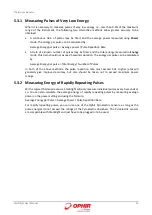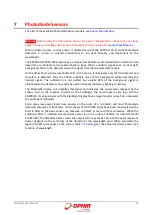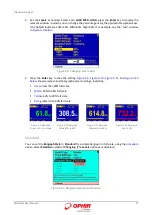
StarBright User Manual
44
8
Pyroelectric and Photodiode Energy Sensors
StarBright supports the PE-C and PD-C series of sensors.
For a list of all the available Pyroelectric and Photodiode Energy Sensor models that can be used
with StarBright, see
Warning:
Before using the energy sensor for power or energy measurement, check that your laser
power, energy, and energy density do not exceed the sensor ratings. See
Topics include:
Pyroelectric Sensors – Method of Operation
Photodiode Energy Sensors – Method of Operation
Measuring Pulses of High Energy Density
Operation of StarBright with Pyroelectric and Photodiode Energy Sensors
8.1
Pyroelectric Sensors – Method of Operation
When a pulsed heat source, such as a laser, is directed at the detector sensor, a temperature
gradient is created across the Pyroelectric crystal mounted in the sensor. An electric charge is
produced which is proportional to the energy absorbed. The detector sensor has sophisticated
circuitry unique to Ophir (patented) that determines the baseline before the pulse is received,
measures the voltage after a pre-determined interval, amplifies it and holds it for a pre-
determined time.
Due to this innovative circuitry, Ophir Pyroelectric sensors can measure very long pulses as well as
short ones. They can measure low energies as well as high. They can also measure at higher
repetition rates than was possible before.
The StarBright meter amplifies this signal and indicates the energy received by the sensor as well
as the frequency at which the laser is pulsing. Using the energy and frequency information,
StarBright is also able to display average power.
8.2
Photodiode Energy Sensors – Method of Operation
The PD10-C and PD10-PJ-C operate in a similar fashion to the Pyroelectric PE-C sensors except it
has a Photodiode detector instead of Pyroelectric. Because of its great sensitivity, it can operate
down to about 1nJ of energy. It has complete wavelength correction over its entire measurement
range of 200 - 1100nm. The PD10-IR-PJ-C is sensitive from 700nm – 1800nm and can measure
energies down to 30 picoJoules.
















































